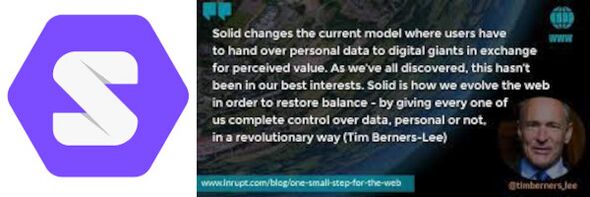The Solid Project
| The Solid Project | |
|---|---|
 The Solid Project | |
| Team Organizations | Inrupt Solid |
| Point of Contact | Tim Berners-Lee |
| Participating Municipalities | Boston MA |
| Sectors | Data |
| Status | Development |
| Last Updated | November 21, 2024 |
Summary
The Solid project is a decentralized platform for the Web that he and a team of researchers at MIT are developing. The goal of the Solid project is to give people more control over their personal data and how it is used by enabling them to store their data on their own servers or "pods," rather than on centralized servers controlled by companies. Solid is based on the idea of linked data, which is a way of representing and connecting information in a way that allows it to be shared and reused across the Web. With Solid, people can choose which applications and organizations have access to their data, and can easily move their data to a different provider if they choose. This gives users more control over their online privacy and allows them to retain ownership of their data. The data is stored in decentralized data pods and accessed by a data graph that uses Web 3.0/ Semantic Web technologies to store, find and access the data.
Decentralised Data Pods
Decentralized data pods are data storage resources that are distributed across a network of computers rather than being stored in a central location. They are often used in decentralized networks, such as blockchain systems, where they are used to store data in a distributed and decentralized manner.
Decentralized data pods may be implemented using a variety of technologies, including distributed file systems, decentralized storage networks, and peer-to-peer networks. They can provide several benefits compared to centralized data storage systems, including improved security, as the data is not stored in a single location that could be vulnerable to attacks, and increased reliability, as the data is stored across multiple locations, making it less likely to be lost in the event of a failure of a single node.
Decentralized data pods may be used for a wide range of applications, including data backup and disaster recovery, distributed computing, and decentralized applications (dApps). They can also be used to store and distribute large amounts of data, such as video or audio files, in a decentralized manner, potentially reducing the reliance on central servers and enabling more efficient and resilient distribution of data.
Web 3.0
Web 3.0, also known as the "Semantic Web," is a vision of the future development of the World Wide Web that focuses on the ability of machines to understand and interpret the meaning of data on the web. Web 3.0 is based on the idea that the web can be made more useful and accessible if the meaning and context of data on the web is explicitly encoded and can be understood by machines. This would allow machines to automatically process and interpret data in ways that are currently only possible through human interpretation, enabling a wide range of new applications and services.
Web 3.0 technologies include semantic markup languages such as RDF (Resource Description Framework) and OWL (Web Ontology Language), which allow data to be annotated with semantic tags that describe its meaning and context. Other technologies include natural language processing and machine learning algorithms, which can be used to extract meaning and context from unstructured data. Web 3.0 is still in the early stages of development, and there is ongoing debate about the best ways to achieve its goals and the potential implications for the web as a whole.